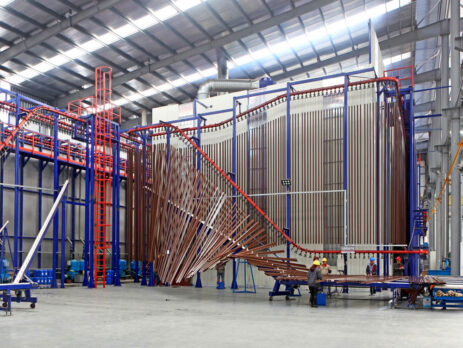양극 처리된 알루미늄: 유기 염색의 차이점 & 전해 착색
알루미늄의 비철금속은 가벼운, 부드러운, 공기 중에서 산화되기 쉬운, 그래서 사람들은 방법을 생각해냅니다., 이것이 알루미늄 산화 공정입니다., 알루미늄 프로파일의 외부 표면은 보호 필름을 성장시킵니다., 튼튼한, 그리고 다채로운 색깔을 염색될 수 있습니다.
소식, 소식, 알루미늄 표면에 화학적으로 안정한 산화물 층을 증착시키는 전해 공정입니다.. 그 결과 산화 피막은 알루미늄의 자연 산화 피막보다 두껍고 강합니다.. The principle of aluminum anodes is a process of decorating and protecting the aluminum and its alloys. In the process of alumina film is formed on aluminum made by direct current under enough voltage through a suitable sulfuric acid electrolyte, the object is the aluminum anode, and by another material or special graphite sheet (lead) as the cathode, electrify time grew out of the required thickness of oxide film.
After the production of the film, except for some aluminum, the next step is to tint. In general, the color of aluminum is mainly divided into the following:
- Organic dyeing
- Inorganic dyeing
- Electrolytic coloring
- Electroplating tinting
Below, we mainly discuss the principles, advantages, and disadvantages of commonly used organic dyes and electrolytic coloring, as well as the use of products:
Electrolytic coloring film with a sulfate electrolytic, on the basis of the transparent anode oxide film in the solution containing metal salt in exchange for electrolytic coloring oxide film (also called secondary electrolyte membrane) of the electrolytic coloring film weather resistance, light fastness and service life is much better than dyeing membrane, its energy consumption and the shading cost is far lower than the overall coloring film again. It is widely used in the coloring of aluminum profiles, but the electrolytic tints are monotonous, usually, only a few of them, such as bronze, 검은 색, golden and date read. And the operation is not easy to control.
Organic dyes, organic dyes based on the adsorption theory of matter, adsorption of physical adsorption and chemical adsorption, physical adsorption is the adsorption of molecules or ions in electrostatic mode; Chemically adsorbed, chemically adsorbed, the two combine to produce organic dyes, usually at a certain temperature. Due to their high anodic oxidation film porosity, adsorption ability to organic dyes, this method colorfast, bright color, easy to operate, the hole sealing treatment after dyeing, the dye can firmly adhere to the membrane pores, improve the anticorrosive ability of the film, fight corrupt ability, until can keep beautiful color, suitable for outdoor use for those who do not need to a large number of aluminum products, indoor use aluminum industrial goods and decorations, colorful and varied in appearance. To meet the needs of modern society to examine and pursue beauty, improve the competitive ability of product market.The organic dye has some characteristics and requirements for the oxide film:
- The oxide film must have sufficient porosity.
- The inner wall of the membrane bore a certain activity.
- The anodic oxide film obtained in sulfuric acid solution is colorless and porous, so it is suitable for dyeing.
- The oxide film must have a certain thickness, and the thinner film layer can only get a very light color.
- The hard anodic oxide film is not suitable for organic dyeing.
- The oxide film layer should be complete, uniform, not due to scratch, sand eye, point corrosion.
- Film itself has the right color, and no difference of metallographic structure, such as grain size or serious segregation, accordingly to the aluminum alloy material also has certain requirements, the alloy of silicon, magnesium, manganese, iron, 구리, chromium content is too high, often can cause oxidation film dark dumb, is generated when the dying color changes.
색상은 입자 크기에 따른 광학 효과의 결과이므로,웹사이트로 문의해주세요:색상은 입자 크기에 따른 광학 효과의 결과이므로 , 색상은 입자 크기에 따른 광학 효과의 결과이므로:sales@vametalsupply.com


 지원
지원 